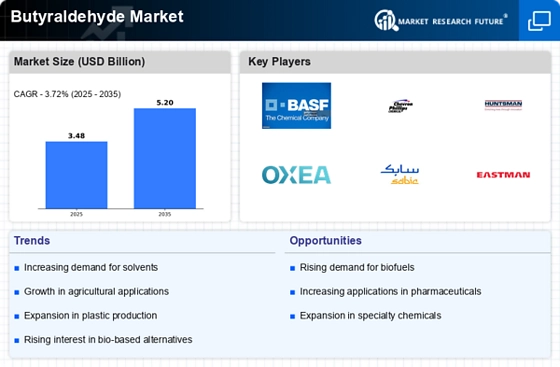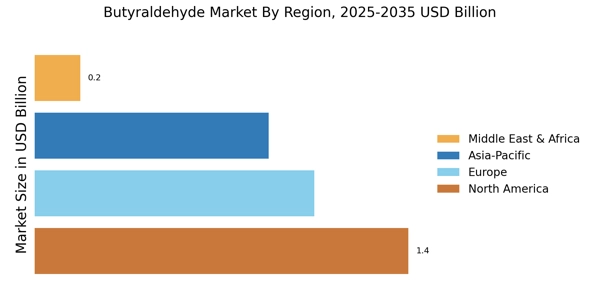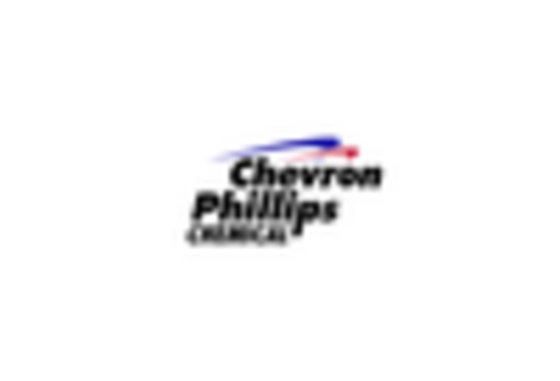Growth in the Paints and Coatings Sector
The Butyraldehyde Market is significantly influenced by the growth of the paints and coatings sector. Butyraldehyde Market is utilized in the production of various resins and coatings, which are essential for enhancing the durability and aesthetic appeal of surfaces. The Butyraldehyde Market is anticipated to reach a valuation of over USD 200 billion by 2026, with a steady CAGR of around 5% during the forecast period. This growth is attributed to increasing construction activities and a rising focus on home improvement projects. As the demand for high-performance coatings escalates, the Butyraldehyde Market is poised to benefit from the heightened consumption of butyraldehyde in formulating advanced coating solutions.
Increasing Use in the Automotive Industry
The Butyraldehyde Market is witnessing a surge in demand driven by its applications in the automotive sector. Butyraldehyde Market is utilized in the production of various automotive components, including adhesives and sealants, which are crucial for vehicle assembly and performance. The automotive industry is projected to grow at a CAGR of approximately 3% over the next few years, fueled by advancements in vehicle technology and an increase in electric vehicle production. As manufacturers seek to enhance vehicle safety and efficiency, the reliance on butyraldehyde-based materials is likely to rise, thereby positively impacting the Butyraldehyde Market. This trend indicates a robust future for butyraldehyde as a vital component in automotive manufacturing.
Regulatory Support for Chemical Manufacturing
The Butyraldehyde Market is positively influenced by regulatory support for chemical manufacturing processes. Governments are increasingly promoting sustainable practices and the use of eco-friendly chemicals, which can enhance the production of butyraldehyde. Regulatory frameworks that encourage the adoption of green chemistry principles are likely to foster innovation in butyraldehyde production methods. This shift towards sustainability may lead to the development of more efficient and less hazardous production techniques, thereby increasing the attractiveness of butyraldehyde in various applications. As regulatory bodies continue to advocate for environmentally responsible practices, the Butyraldehyde Market is expected to thrive in this evolving landscape.
Expansion of the Personal Care and Cosmetics Sector
The Butyraldehyde Market is also benefiting from the expansion of the personal care and cosmetics sector. Butyraldehyde Market is employed in the formulation of various fragrances and cosmetic products, contributing to their sensory appeal. The Butyraldehyde Market is expected to exceed USD 400 billion by 2025, with a CAGR of around 5.5%. This growth is driven by increasing consumer awareness regarding personal grooming and the rising demand for premium beauty products. As brands strive to innovate and differentiate their offerings, the incorporation of butyraldehyde in fragrance formulations is likely to enhance its market presence, thereby supporting the Butyraldehyde Market.
Rising Demand for Butyraldehyde in Chemical Synthesis
The Butyraldehyde Market is experiencing a notable increase in demand due to its essential role in chemical synthesis. This compound serves as a precursor for various chemicals, including butanol and plasticizers, which are integral to numerous industrial applications. The market for butanol, for instance, is projected to grow at a compound annual growth rate (CAGR) of approximately 4.5% over the next few years, thereby driving the need for butyraldehyde. Furthermore, the versatility of butyraldehyde in producing agrochemicals and pharmaceuticals enhances its market appeal. As industries seek to optimize production processes, the reliance on butyraldehyde as a key ingredient in chemical formulations is likely to expand, thereby bolstering the Butyraldehyde Market.


















Leave a Comment